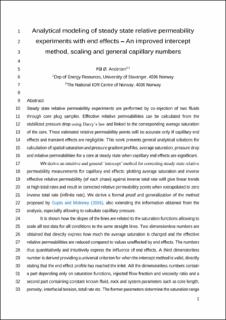| dc.contributor.author | Andersen, Pål Østebø | |
| dc.date.accessioned | 2021-08-05T13:26:28Z | |
| dc.date.available | 2021-08-05T13:26:28Z | |
| dc.date.created | 2021-08-03T18:30:33Z | |
| dc.date.issued | 2021 | |
| dc.identifier.citation | Andersen, P.Ø. (2021) Analytical modeling of steady state relative permeability experiments with end effects – An improved intercept. Oil & Gas Science and Technology, method, scaling and general capillary numbers. | en_US |
| dc.identifier.issn | 1294-4475 | |
| dc.identifier.uri | https://hdl.handle.net/11250/2766559 | |
| dc.description.abstract | Steady state relative permeability experiments are performed by co-injection of two fluids through core plug samples. Effective relative permeabilities can be calculated from the stabilized pressure drop using Darcy’s law and linked to the corresponding average saturation of the core. These estimated relative permeability points will be accurate only if capillary end effects and transient effects are negligible. This work presents general analytical solutions for calculation of spatial saturation and pressure gradient profiles, average saturation, pressure drop and relative permeabilities for a core at steady state when capillary end effects are significant. We derive an intuitive and general ‘intercept’ method for correcting steady state relative permeability measurements for capillary end effects: plotting average saturation and inverse effective relative permeability (of each phase) against inverse total rate will give linear trends at high total rates and result in corrected relative permeability points when extrapolated to zero inverse total rate (infinite rate). We derive a formal proof and generalization of the method proposed by Gupta and Maloney (2016), also extending the information obtained from the analysis, especially allowing to calculate capillary pressure.
It is shown how the slopes of the lines are related to the saturation functions allowing to scale all test data for all conditions to the same straight lines. Two dimensionless numbers are obtained that directly express how much the average saturation is changed and the effective relative permeabilities are reduced compared to values unaffected by end effects. The numbers thus quantitatively and intuitively express the influence of end effects. A third dimensionless number is derived providing a universal criterion for when the intercept method is valid, directly stating that the end effect profile has reached the inlet. All the dimensionless numbers contain a part depending only on saturation functions, injected flow fraction and viscosity ratio and a second part containing constant known fluid, rock and system parameters such as core length, porosity, interfacial tension, total rate etc. The former parameters determine the saturation range and shape of the saturation profile, while the latter number determines how much the profile is compressed towards the outlet. End effects cause the saturation profile and average saturation to shift towards the saturation where capillary pressure is zero and the effective relative permeabilities to be reduced compared to the true relative permeabilities. This shift is greater at low total rate and gives a false impression of rate-dependent relative permeabilities. The method is demonstrated with multiple examples. Methodologies for deriving relative permeability and capillary pressure systematically and consistently, even based on combining data from tests with different fluid and core properties, are presented and demonstrated on two datasets from the literature. | en_US |
| dc.language.iso | eng | en_US |
| dc.publisher | EDP Open | en_US |
| dc.subject | petroleumsteknologi | en_US |
| dc.title | Analytical modeling of steady state relative permeability experiments with end effects – An improved intercept method, scaling and general capillary numbers | en_US |
| dc.type | Peer reviewed | en_US |
| dc.type | Journal article | en_US |
| dc.description.version | acceptedVersion | en_US |
| dc.subject.nsi | VDP::Teknologi: 500::Berg‑ og petroleumsfag: 510::Petroleumsteknologi: 512 | en_US |
| dc.source.journal | Oil & gas science and technology | en_US |
| dc.identifier.cristin | 1923734 | |
| cristin.ispublished | true | |
| cristin.fulltext | postprint | |
| cristin.qualitycode | 1 | |
